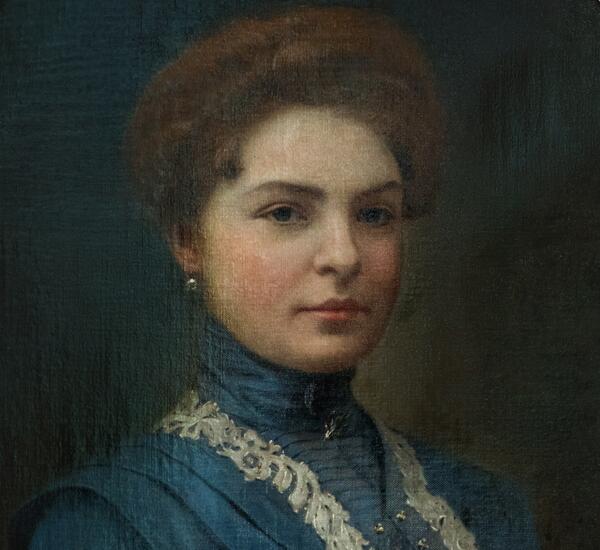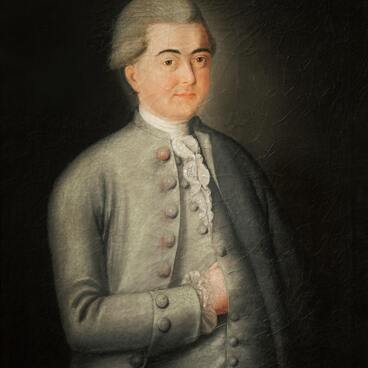The collection of the museum presents a portrait of Nina Vidyakina, née Reutova. She was born in Moscow in 1886 and brought up among the people of the merchant Zamoskvorechye. She received an excellent education for a woman of that time: she spoke three languages, played musical instruments, and studied at the Stroganov School, which trained artists of decorative and applied arts.
The Reutov family was familiar with the town’s artistic elite. The uncle of Nina’s mother, Ivan Shanin, was friends with the playwright Alexander Ostrovsky. Shanin had the talent of giving accurate characteristics — it was his stories that were used by Ostrovsky for some of his plays.
In Moscow, Nina Reutova met the Arkhangelsk merchant Pyotr Vidyakin, who was sent by his father to establish contacts with the local merchants. The girl left her studies at the Stroganov School, married Vidyakin and followed him to Arkhangelsk.
Wishing to please his beautiful and educated daughter-in-law, Pyotr Vidyakin senior decided to order a portrait of Nina. Using his connections in Europe, he agreed that the portrait would be made in an art workshop in Vienna. This choice was not spontaneous: Vidyakin had a trading house “P.G. Vidyakin and Sons” on Troitsky Prospect, where the then-famous bent “Viennese” furniture was sold. The shop also traded porcelain from European and Russian factories, crystal, lighting instruments and much more.
A photograph of Nina was sent to Vienna together with a piece of blue fabric from the dress in which she should be depicted, samples of jewelry, trimmings, buttons and even a lock of her red hair. With all this in front of him, the unknown artist proceeded to the portrait. This method of fulfilling orders was popular in the late 19th century, even among such venerable artists as Ivan Kramskoi.
The fate of Nina Vidyakina was sad. In January 1938, her husband was sentenced to the firing squad. In 1944, she was arrested and then sent to a camp in Komi. A few months later, the middle daughter, Galina, was placed under arrest as well. In 1956, the term of serving in the camp ended, but Nina Vidyakina was not allowed to live in Arkhangelsk, she was sent to Kazakhstan, where was joined by her daughter Galina. Both were rehabilitated in 1958.
The Reutov family was familiar with the town’s artistic elite. The uncle of Nina’s mother, Ivan Shanin, was friends with the playwright Alexander Ostrovsky. Shanin had the talent of giving accurate characteristics — it was his stories that were used by Ostrovsky for some of his plays.
In Moscow, Nina Reutova met the Arkhangelsk merchant Pyotr Vidyakin, who was sent by his father to establish contacts with the local merchants. The girl left her studies at the Stroganov School, married Vidyakin and followed him to Arkhangelsk.
Wishing to please his beautiful and educated daughter-in-law, Pyotr Vidyakin senior decided to order a portrait of Nina. Using his connections in Europe, he agreed that the portrait would be made in an art workshop in Vienna. This choice was not spontaneous: Vidyakin had a trading house “P.G. Vidyakin and Sons” on Troitsky Prospect, where the then-famous bent “Viennese” furniture was sold. The shop also traded porcelain from European and Russian factories, crystal, lighting instruments and much more.
A photograph of Nina was sent to Vienna together with a piece of blue fabric from the dress in which she should be depicted, samples of jewelry, trimmings, buttons and even a lock of her red hair. With all this in front of him, the unknown artist proceeded to the portrait. This method of fulfilling orders was popular in the late 19th century, even among such venerable artists as Ivan Kramskoi.
The fate of Nina Vidyakina was sad. In January 1938, her husband was sentenced to the firing squad. In 1944, she was arrested and then sent to a camp in Komi. A few months later, the middle daughter, Galina, was placed under arrest as well. In 1956, the term of serving in the camp ended, but Nina Vidyakina was not allowed to live in Arkhangelsk, she was sent to Kazakhstan, where was joined by her daughter Galina. Both were rehabilitated in 1958.



